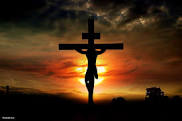Background Passages: Mark 15:21-47; Phil. 2:6-8; John 3:16
The legend of King Arthur and Camelot reads as a favorite of many since it first appeared on the French literary scene in the 12th century. As a movie, released in 1967, the tale gained popular acclaim. In the movie’s climatic scene, King Arthur discovered the adulterous relationship between Queen Guinevere and Lancelot, the king’s most trusted and loved knight. Though Lancelot escaped capture, Guinevere, having broken the laws of Camelot, is tried and convicted, sentenced to burn at the stake. Arthur, deeply torn between his devotion to the laws of his beloved kingdom and his passion for Guinevere, faces an unholy predicament.
Mordred, King Arthur’s scheming, illegitimate son, dances in glee at Arthur’s “magnificent dilemma.” He says, “Let her die, your life is over. Let her live, your life’s a fraud. Which will it be, Arthur? Do you kill the queen or kill the law?” As the tragedy unfolds, Arthur stoically sacrifices his true love, “Let justice be done.”
The king watches in horror, heart shattered, as the guards lead Guinevere into the castle courtyard. The executioner chains her to the stake, waiting with his torch for the king’s signal to set the pyre ablaze. In the gripping agony of love, Arthur gives into his breaking heart. “I cannot let her die.” Mordred, relishing the downfall of the king, mutters, “Well, you are human after all, aren’t you, Arthur? Human and helpless.”
Guinevere is spared, but the dream of Camelot crumbles.
In his book, Windows of the Soul, Ken Gire compares the cross of Calvary with that climatic scene in the castle courtyard of Camelot. Think about it. God created his world and all within it and called it “good.” He loved his people so much that he made with them a covenant of relationship, a promise never broken by the Father. He loved them with all his being.
He handed them a set of principles by which they should live, asking for their obedience and commitment. Time and time again the world proved unfaithful, lost in the quagmire of its self-interest, rebellion and sin. Time and time again, the world was tried, convicted and deserving of death.
In the shadows, Satan gleefully watched as God faced his magnificent dilemma. “Let the world die, your life is over. Let the world live, your life’s a fraud. Which will it be, God? Do you kill the world or kill the law?”
Satan saw only a no-win scenario. God must turn away from his call to righteousness and ignore the sin of the world or hold to his principles and punish the world he loved. Either way. Satan wins. God loses. God, heart heavy in sorrow said, “I cannot let them die.” Satan smiled, relishing what he saw as the downfall of the Heavenly King. Helpless. But God was not finished with his redemptive act.
Filled with love for his created, the King left his throne. Took off his crown. Laid aside his scepter. Shrugged the royal robe from his shoulders. Traded his castle for a cross.
“Who, being the very nature God, did not consider equality with God something to be grasped, but made himself nothing, taking the very nature of a servant, being made in human likeness. And being found in appearance as a man, he humbled himself and became obedient to death-even death on the cross!” Phil. 2:6-8
God took the sins of the world upon himself through his “only begotten son.” A sacred, sacrificial substitute for a world that deserved to die. Today, we still find it difficult to comprehend because we are incapable of loving anything as God so loved his children. For those of us who accept by faith the grace that is the cross, we find a promise of life eternal in the arms of a living Lord who loves us as no other loves us. God’s third option remains the hope for the world.
In a story of love and justice, Camelot ends in tragedy. Gire said it best, “When love and justice collide, only the Cross offers a happy ending.”
“For God so loved the world that he gave his only son that whosoever believes in him should not perish but have everlasting life.” John 3:16
